5G

Overview
- In the era of high-speed communications and IoT, large quantities of antennas and sensors will be introduced.
- Equipment will overflow into the city and home, impairing the landscape and design.
- Utilizing the radio wave permeability of microcellular plastic (MCP) and the light-reflective and light-diffusive properties, this product realizes improved landscape and design by the illumination of which the antenna/sensor is integrated.
Table
- Coming age of High-speed communications and IoT
- Increasing telecommunications equipment and sensors
- Concept of antenna/sensor and lighting integration
- Radio wave permeability and light reflection/light diffusion of microcellular plastic (MCP)
- Characteristics of microcellular plastic (MCP)
- About new development
Foaming makes the plastic low dielectric, and the dielectric constant (Dk) and dissipation factor (Df) greatly decrease. Furthermore, our proprietary Microcellular (= MC) technology enables the uniform formation of microcellular in plastic materials that are smaller than 10 micrometers in size, making them a material with a small cell diameter, even when compared to millimeter-wave- level high-frequency wavelengths. Therefore, it behaves as a material that penetrates radio waves almost completely.
On the other hand, microcellular plastic (MCP) is a material with good light reflectivity and light diffusivity over the entire visible light range.
Using these two features at the same time, a board that transmits and receives radio waves is placed behind a light-diffusing reflector formed of microcellular plastic (MCP). This board can be used for highly design-oriented lighting fixtures that combine the functions of wireless communications and lighting.
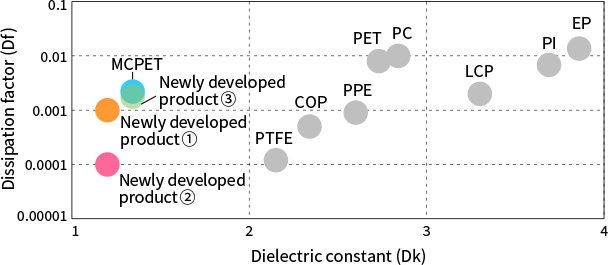
If you are in trouble with the location of the antenna, radio, or sensor, please feel free to contact us below.
Coming age of High-speed communications and IoT
Mobile communication systems began with 1G, a voice-based analogue system in the 1980s, and in the 1990s 2G, a digital system that enabled e-mail and Web viewing, became the mainstream, and in the 2000s the provision of 3G that enabled high-speed data communication centered on images began. 4G services began around 2015, enabling ultra-high-speed data communications centered on videos via smartphones and tablets. From the second half of 2010 to 2020, 5G (fifth-generation mobile communications) services were launched worldwide.
It is expected that 5G communications will reach 10 times faster than 4G, making it easier to watch videos on smart phones and other features that contribute to the evolution of autonomous driving systems and IoT (Internet of things) that all things around you are networking.
Increasing telecommunications equipment and sensors
The main features of 5G communications include three points: high-speed, large-capacity, high reliability, low latency, and multiple simultaneous connections. On the other hand, the higher the frequency of radio waves, the more attenuated it is and the shorter the reach distance, so that, for example, 5G radio waves in 28GHz band reach only about 100m distances. Therefore, to expand 5G coverage, base stations must be installed for each 100m.
And, because of the high level of straightness, there are many areas where radio waves cannot reach due to obstacles, it is expected that auxiliary mechanisms such as repeaters will be indispensable, especially indoors.
In addition, as we move toward IoT community, we expect that not only home appliances, but also various types of houses and buildings will be measured, digitized, and become smarter. As a result, the number of sensors that can be used will also increase significantly. At that time, the problem is how to efficiently deliver the radio waves of repeaters and sensors, and how to introduce them seamlessly into the city and homes.
Concept of antenna/sensor and lighting integration
Lighting fixtures are installed in many places with good visibility in order to illuminate the city and homes widely. In addition, there are many signboards not only for lighting, but also for advertising and display in the city.
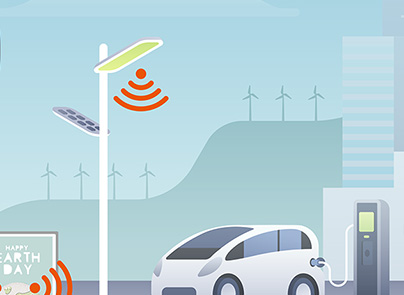
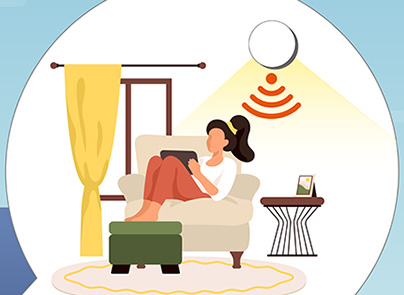
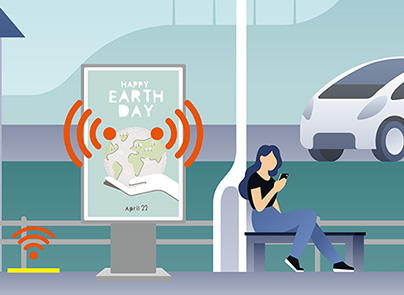
The same is required for the location of antennas and sensors. Therefore, if the functions of the antenna and sensor can be integrated into the lighting, the space for introducing new equipment can be saved for that purpose, and a more sophisticated landscape and space can be realized.
In order to realize these concepts, we need materials that simultaneously satisfy both radio wave permeability and light reflection/light diffusion in the visible light range, such as microcellular plastics (MCP).
Radio wave permeability and light reflection/light diffusion of microcellular plastic (MCP)
Fig. 2 and 3 shows the permeability of radio waves. In contrast to non-foamed materials, microcellular plastics (MCP) has greatly improved radio wave permeabilities. Another important feature of this material is the lack of frequency dependence in its permeabilities.
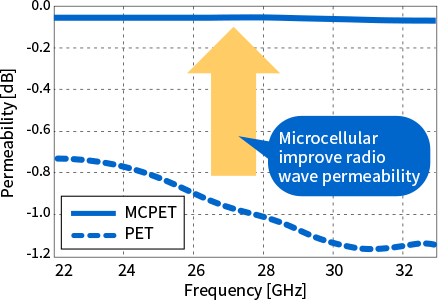
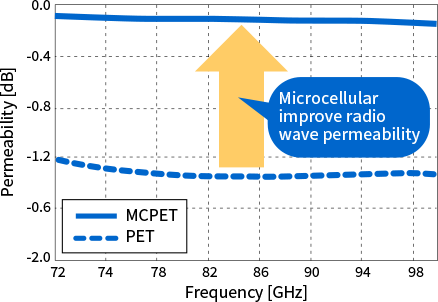
Fig. 4 shows the permeability of a sample when the incident angle of the radio wave is changed. Microcellular plastics (MCP) is a material that maintains high permeability even when radio waves enter at shallow angles, with little angular dependency.
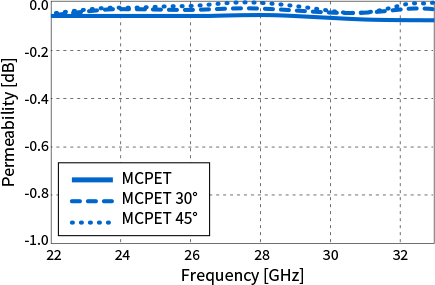
In both cases, the attenuation of the radio wave strength in the microcellular plastics (MCP) is less than 0.1db, and it has extremely good radio wave permeabilities. On the other hand, Fig. 5 shows the light-reflection of MCPET. It has extremely high reflection in the whole band of visible light.
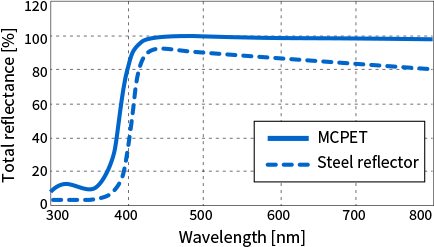
(NOTE) Reflectivity is relative to aluminum oxide plate.
In addition, microcellular plastics (MCP) can be molded and punched from the sheet-shape. We also accept technical consultations regarding uncertainties, such as uncertainty about whether the product can be molded into the preferred shape. Please feel free to contact us.
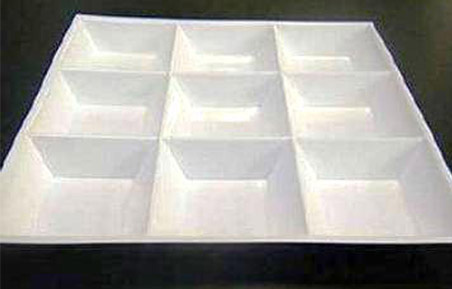
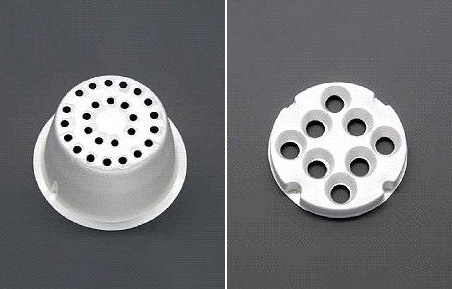
As mentioned above, microcellular plastic (MCP) is a material that not only achieves high-level radio wave permeability and visible-light reflectivity but can also be shaped to suit illumination shapes. Therefore, by placing a radio board behind a microcellular plastic (MCP) reflector, it can be integrated with illumination and show its capability as an antenna or sensor.
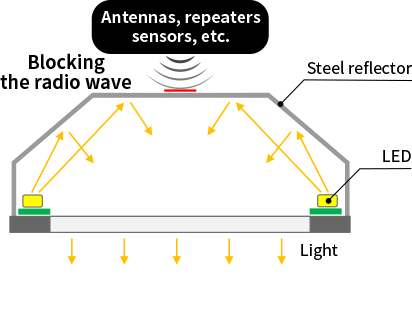
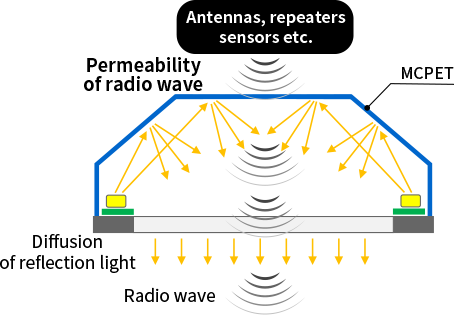
This concept is not realized with a steel reflector. Since steel doesn’t transmit radio waves, placing antennas or sensors behind them will not work as a radio device.
Characteristics of microcellular plastic (MCP)
| MCPET | MCPC(newly developed product③) | |
|---|---|---|
| Density(g/cm3) | 0.33 | 0.38 |
| Dielectric constant (Dk) | 1.2 | 1.2 |
| Dissipation factor (Df) | 0.0017 | 0.0015 |
About new development
Furukawa Electric can try to foam plastic materials other than the existing lineup according to the customer's requirements. In addition to dielectric constant Dk and dissipation factor Df, we will propose new foamed plastics based on our development capability of composition (blending) and foaming technology through experiments, if you inform us of various requirements such as flame resistance, heat resistance, thickness, density, etc.
Please click here to contact us.

